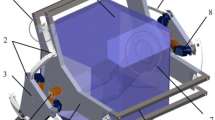Abstract
To overcome the kinematic singularity limitation of simulator, which is unavoidable in a three-axis architecture, an all-attitude flight simulator in a four-axis architecture is proposed. The simulator can always provide 3DOF motion by applying redundant manipulator mechanism. For direct kinematics of the manipulator, a dual-Euler method is adopted to solve the expressions of attitude angles; thus computation singularity of all-attitude angles is overcome. For inverse kinematics of the manipulator, pseudo-inverse gradient projection method is used to obtain optimal velocity solution. Then, based on dynamic control method, optimal position solution is obtained. The proposed inverse kinematics algorithm can achieve desired attitudes, as well as can avoid kinematics singularity and axis angle limits. The simulation results show that the kinematic performance of the four-axis all-attitude flight simulator is superior to that of a three-axis simulator.
Similar content being viewed by others
References
Moody L. The history and future of flight control simulation. In: Proceedings of AIAA Modeling and Simulation Technologies Conference and Exhibit. Providence: AIAA, 2004. 5149–5159
Dickes E G, Ralston J N, Lawson K. Application of large-angle data for flight simulation. In: Proceedings of AIAA Modeling and Simulation Technologies Conference and Exhibit. Denver: AIAA, 2000. 4584–4598
Sciavicco L, Siciliano B. Modeling and Control of Robot Manipulators. London: Springer, 2000. 10–60
Shibata T, Murakami T. Null space motion control by PID control considering passivity in redundant manipulator. IEEE Trans Indust Inf, 2008, 4: 261–270
Mao Z Q, Hsia T C. Obstacle avoidance inverse kinematics solution of redundant robots by neural networks. Robotica, 1997, 15: 3–10
Deo A S, Walker I D. Minimum effort inverse kinematics for redundant manipulators. IEEE Trans Robot Automat, 1997, 13: 767–775
Xia Y, Wang J. A dual neural network for kinematic control of redundant robot manipulators. IEEE Trans Syst Man Cybern, 2001, 31: 147–154
Stilwell D J, Bishop B E, Sylvester C A. Redundant manipulator techniques for partially decentralized path planning and control of a platoon of autonomous vehicles. IEEE Trans Syst Man Cybern, 2005, 35: 842–848
Bhatia R. Matrix Analysis. Berlin: Springer, 1997. 128–134
Huang X Q. A dual-euler method for solving all-attitude angles of the aircraft. In: Proceedings of AIAA Flight Simulation Technologies Conference. Monterey: AIAA, 1993. 257–262
Li Y J, Yan C. Improvement of dua1 Euler method for full scale Eulerian angles solution of aircraft. J Beijing Univ Aeronaut Astronaut, 2007, 33: 505–508
Deng Z L. Inertial Technology. Harbin: Harbin Institute of Technology Press, 2006. 96–99
Choi Y. Singularity-robust inverse kinematics using lagrange multiplier for redundant manipulators. J Dyn Sys Meas Control, 2008, 130: 1–7
Liu Y, Jiang Y M, Sun L N. Research on parallel optimization scheme between singularity avoidance and minimum torque for a redundant manipulator. J Harbin Institute Tech, 2006, 38: 30–34
Patel R V, Shadpey F. Control of Redundant Robot Manipulators: Theory and Experiments. Berlin: Springer, 2005. 8–33
Shimizu M, Kakuya H, Yoon W K, et al. Analytical inverse kinematic computation for 7-DOF redundant manipulators with joint limits and its application to redundancy resolution. IEEE Robot, 2008, 24: 1131–1142
Zhao Z F, Zhang Q X. Kinematic optimization of redundant robot manipulators. J Beijing Institute Tech, 1995, 15: 409–414
Bogacki P, Shampine L F. A 3(2) pair of Runge-Kutta formulas. Appl Math Lett, 1989, (2): 1–9
Author information
Authors and Affiliations
Corresponding author
Rights and permissions
About this article
Cite this article
Wang, X., Zhao, H., Ma, K. et al. Kinematics analysis of a novel all-attitude flight simulator. Sci. China Inf. Sci. 53, 236–247 (2010). https://doi.org/10.1007/s11432-010-0042-8
Received:
Accepted:
Published:
Issue Date:
DOI: https://doi.org/10.1007/s11432-010-0042-8




